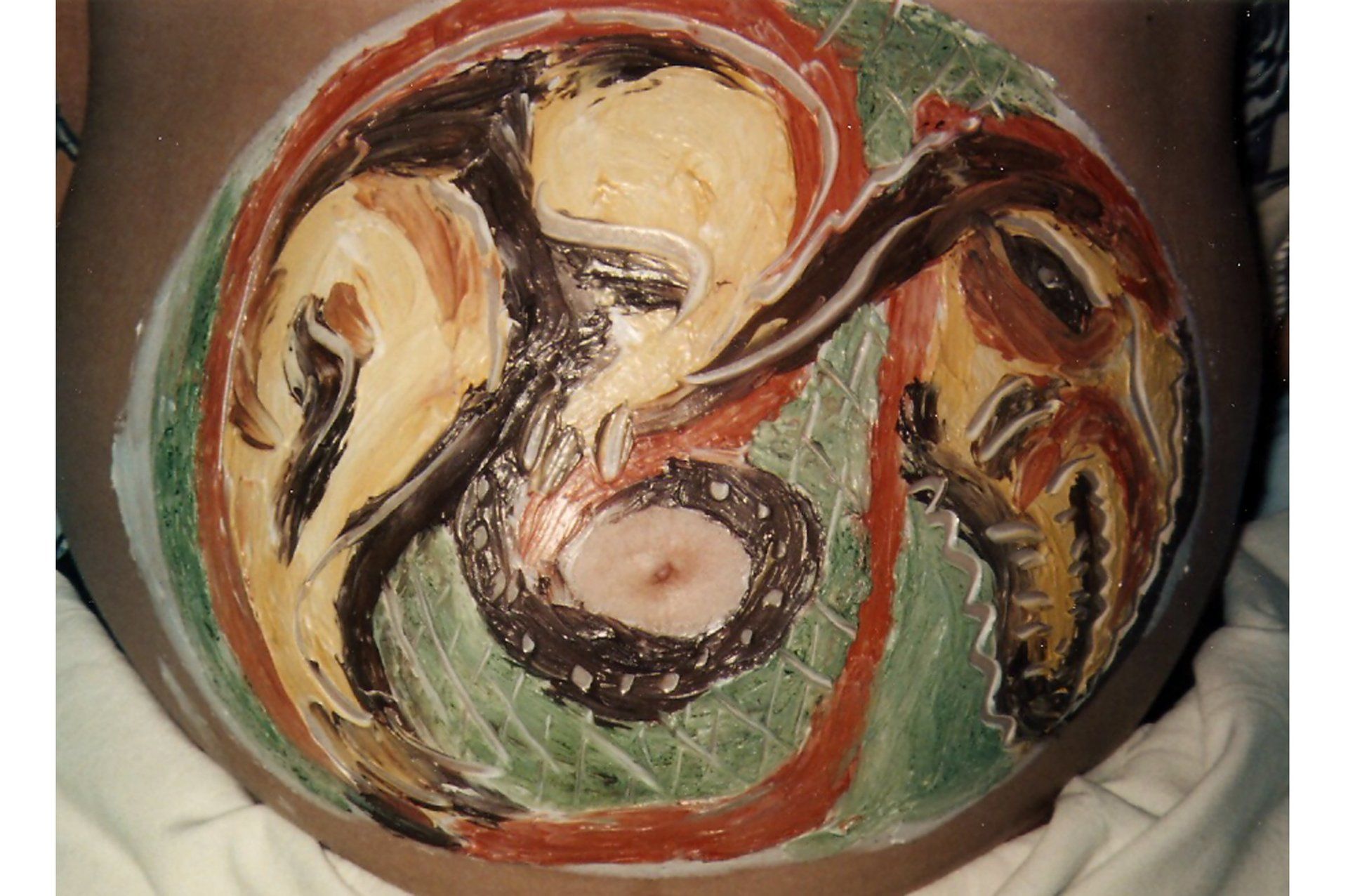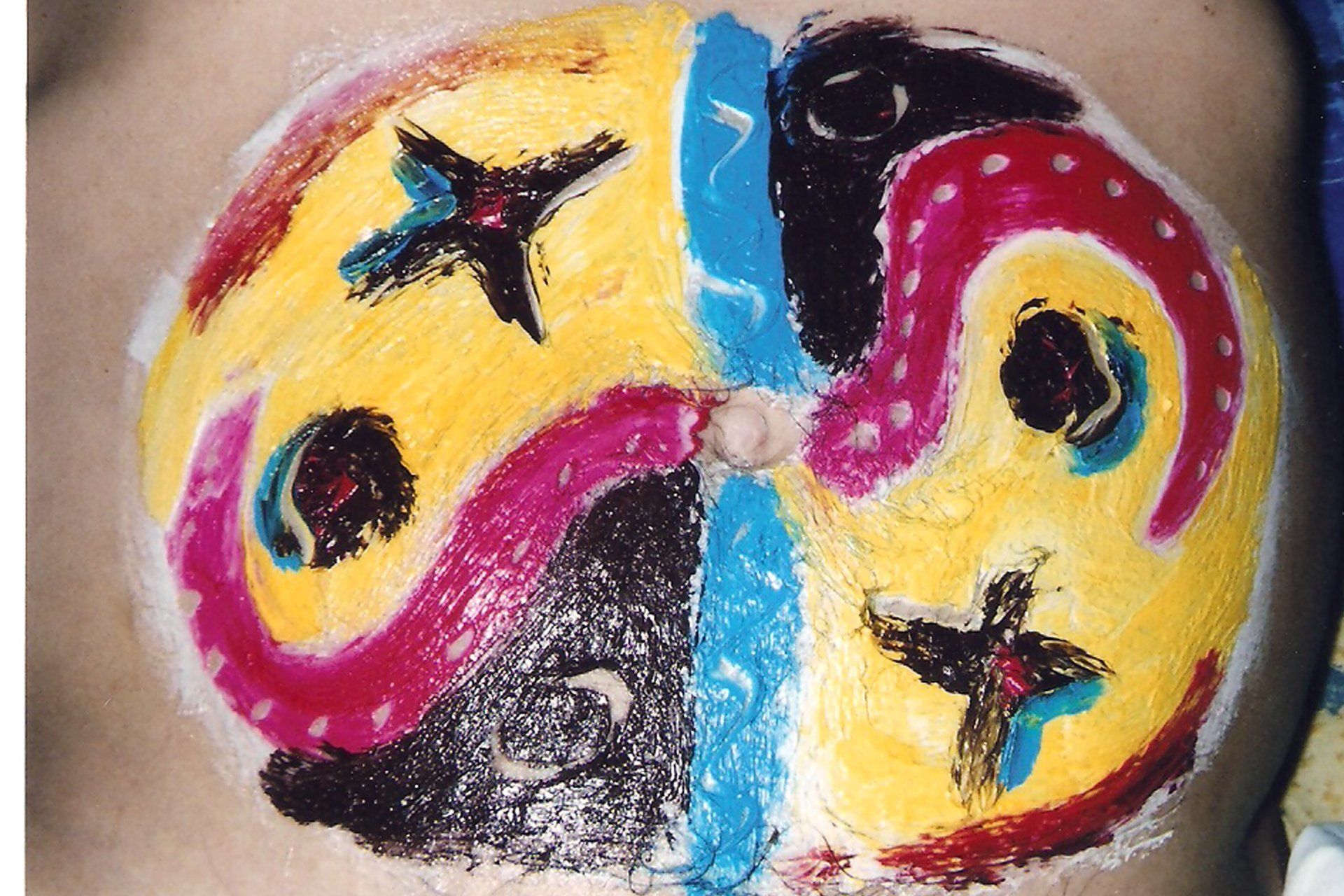Act II
I am the navel of the world
2006/2007
10 belly button, 2 phases, 10 objects,
20 performances, 20 transfers
5 painted navels in France,
5 painted navels in Lanzarote (Canary Islands, Spain)
back
10 belly button, 2 phases, 10 objects,
20 performances, 20 transfers
5 painted navels in France,
5 painted navels in Lanzarote (Canary Islands, Spain)
For all, the navel is the inner center even if it does not have the same symbolic representation for a man and a woman. The belly can be likened to instinctive impulses and also evoke the inner world. It is the trace, the passage from one world to another, an indelible link as the continuity of Man.
In the present-day Western imagination as in primitive mythologies, fantasies and drives take on a zoomorphic character: the animal represents the intermediate being between the unspeakable and humanity, between unconscious anonymity and subjectivity, as collective unconscious including a form of anonymity, meaning elective of repressed instincts.
A human being is determined by its singularity, an animal is determined by its membership in a species. By moving from humanity to animality, we reach the register in which the boundaries between each Moi are fading away from the others (for example, to grab the power of an animal by identification with the animal).
Painting on the bellies was a completely different experience of the backs. This time we were face to face! I wondered how each of us would react, if the eyes of one and the other would be an obstacle, because it is not so easy to be touched belly, sensitive part of the body. It was an interesting experience, I was surprised by the investment of people some of whom entrusted me with objects that they hold dear. In Lanzarote, the language barrier was no obstacle (I started learning Spanish on the spot) despite my fears.
Act II took place in two phases of painting on the belly, around the navel leaving it intact, as untouchable. We must see the navel in the center of the painting as an eye: the look of our inner world at the same time as the look on the outside. I also kept, in photo, the skin around the painting (unlike the paintings of the backs that were cut), another eye encompassing the eye-navel.
The prints were made by transfers on cotton canvas, more flexible than the paper, which allowed me to take the imprint in full.
The questions :
Phase 1: If an animal were to represent you, what would it be?
Phase 2: what does it represent for you?
Phase 3: And to answer the question: what is its attribute? or what do you attribute to it? I ask them to give me an object (organic or not).
The song "le navel" (Norge / Philippe-Gérard) sung by Jeanne Moreau will accompany this work and will be part of the exhibition. Ed. Majestic - (p) 1981 Productions Jacques Canetti.
The exhibition :
The pictures of the painted bellies have been enlarged to be the same size as the transfers (30 x 40) and glued on cardboard. Two sticks are stuck on the top and bottom of the transfers, hooking with pliers. Photos and footprints of the same navel are staged together with the inherent object, to allow a unity in the interpretation of the animal, in the form of "tables". This object is the material representation of the person. The proposals are printed on paper pasted on cardboard and positioned above their representation (photos, transfers, objects). The object is suspended in the center between the two phases of painting.
In the present-day Western imagination as in primitive mythologies, fantasies and drives take on a zoomorphic character: the animal represents the intermediate being between the unspeakable and humanity, between unconscious anonymity and subjectivity, as collective unconscious including a form of anonymity, meaning elective of repressed instincts.
A human being is determined by its singularity, an animal is determined by its membership in a species. By moving from humanity to animality, we reach the register in which the boundaries between each Moi are fading away from the others (for example, to grab the power of an animal by identification with the animal).
Painting on the bellies was a completely different experience of the backs. This time we were face to face! I wondered how each of us would react, if the eyes of one and the other would be an obstacle, because it is not so easy to be touched belly, sensitive part of the body. It was an interesting experience, I was surprised by the investment of people some of whom entrusted me with objects that they hold dear. In Lanzarote, the language barrier was no obstacle (I started learning Spanish on the spot) despite my fears.
Act II took place in two phases of painting on the belly, around the navel leaving it intact, as untouchable. We must see the navel in the center of the painting as an eye: the look of our inner world at the same time as the look on the outside. I also kept, in photo, the skin around the painting (unlike the paintings of the backs that were cut), another eye encompassing the eye-navel.
The prints were made by transfers on cotton canvas, more flexible than the paper, which allowed me to take the imprint in full.
The questions :
Phase 1: If an animal were to represent you, what would it be?
Phase 2: what does it represent for you?
Phase 3: And to answer the question: what is its attribute? or what do you attribute to it? I ask them to give me an object (organic or not).
The song "le navel" (Norge / Philippe-Gérard) sung by Jeanne Moreau will accompany this work and will be part of the exhibition. Ed. Majestic - (p) 1981 Productions Jacques Canetti.
The exhibition :
The pictures of the painted bellies have been enlarged to be the same size as the transfers (30 x 40) and glued on cardboard. Two sticks are stuck on the top and bottom of the transfers, hooking with pliers. Photos and footprints of the same navel are staged together with the inherent object, to allow a unity in the interpretation of the animal, in the form of "tables". This object is the material representation of the person. The proposals are printed on paper pasted on cardboard and positioned above their representation (photos, transfers, objects). The object is suspended in the center between the two phases of painting.
FRANCE
Transfert (c) Valja
Phase 1: If an animal were to represent you, what would it be?
Le chien
(the dog)
City skyline
Photo By: John Doe
Button
Transfert (c) Valja
Phase 3: the object
A shell
Holidays, what's left, what's going on over time
***
Transfert (c) Valja
Phase 1: If an animal were to represent you, what would it be?
Le serpent
(the snake)
City skyline
Photo By: John Doe
Button
Phase 2 : What does it represent?
Serenity, bewitchment, fear, agility
City skyline
Photo By: John Doe
Button
Transfert (c) Valja
Phase 3 : l'objet
A small golden key
Opening to the world
***
Transfert (c) Valja
Phase 1: If an animal were to represent you, what would it be?
Le singe
(The monkey)
City skyline
Photo By: John Doe
Button
Phase 2 : What does it represent?
The species closest to the human.
And I do not want to be an animal
City skyline
Photo By: John Doe
Button
Transfert (c) Valja
Phase 3 : l'objet
A plush toy
Offered by my son, makes me love life
***
Transfert (c) Valja
Phase 1: If an animal were to represent you, what would it be?
Le lion
City skyline
Photo By: John Doe
Button
Phase 2 : What does it represent?
Finesse, strength, power, serenity.
It's my astral sign
City skyline
Photo By: John Doe
Button
Transfert (c) Valja
Phase 3: the object
ribbons
Remembering a deceased friend, to think of him concretely
***
Transfert (c) Valja
Phase 1: If an animal were to represent you, what would it be?
L'escargot
(The snail)
City skyline
Photo By: John Doe
Button
Transfert (c) Valja
Phase 3 : l'objet
Pubic hair
A.D.N.
***
SPAIN
Transfert (c) Valja
Phase 1: If an animal were to represent you, what would it be?
Araña (spider)
City skyline
Photo By: John Doe
Button
Phase 2 : What does it represent?
Perfecciòn y simetria (perfection and symmetry)
City skyline
Photo By: John Doe
Button
Transfert (c) Vallja
Phase 3: the object
Concha (shell)
Perfecciòn (perfection)
***
Transfert (c) Valja
Phase 1: If an animal were to represent you, what would it be?
Canario (canari)
City skyline
Photo By: John Doe
Button
Transfert (c) Valja
Phase 3 : l'objet
Una pluma (a feather)
Alas (the wings)
***
Transfert (c) Valja
Phase 1: If an animal were to represent you, what would it be?
Delphin (dolfin)
City skyline
Photo By: John Doe
Button
Phase 2 : What does it represent?
La vida solidaria
(solidarity life )
City skyline
Photo By: John Doe
Button
Transfert (c) Valja
Phase 3 : l'objet
Pulsera (bracelet)
Poder hacer todo, polivalencia (can do everything, versatility)
***
Transfert (c) Valja
Phase 1: If an animal were to represent you, what would it be?
El pez (the fish)
City skyline
Photo By: John Doe
Button
Phase 2 : What does it represent?
Libertad de movimiento
(freedom of movement)
City skyline
Photo By: John Doe
Button
Transfert (c) Valja
Phase 3 : l'objet
Copa, elastico para el pelo y agua
(verre, élastique pour cheveux et eau)
Estar en comuniòn con la naturaleza, ser parte de ella
(to be in communion with nature, to be part of it)
***
Transfert (c) Valja
Phase 1: If an animal were to represent you, what would it be?
El delphin (dolfin)
City skyline
Photo By: John Doe
Button
Phase 2 : What does it represent?
Inteligencia, fuerza, belleza
(intelligence, strength, beauty)
City skyline
Photo By: John Doe
Button
Transfert (c) Valja























